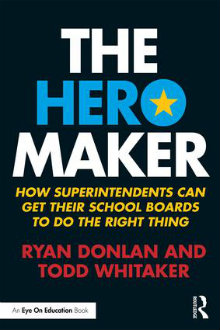How to Maximize School Board Effectiveness
The Hero Maker: How Superintendents Can Get Their School Boards To Do The Right Thing
By Ryan Donlan and Todd Whitaker
(Routledge/Eye On Education, 2017 – Learn more)

This is a needed, practical book for superintendents, school leaders, and others who want to know how districts work and how key decision makers should function in terms of school governance and working relationships.

The relationship between the superintendent and school board is complex. Whereas most of us have one boss, the superintendent has a group of people over him or her who may or may not function well together. Yet a superintendent must lead his or her bosses, a group with elected authority but diverse backgrounds and education.
The authors don’t mince words: “Sometimes just getting them to ‘play nice’ in public can be a challenge.”
Understanding school board members
The authors tell us directly and honestly what board members have in common: Each wants to be a hero in the eyes of someone who matters to them. This is such an other-centered, ethical way of looking at the world, that it might seem revolutionary to many.
Many constituencies, or groups, influence the superintendent’s life, groups that don’t always see the whole picture. When board members meet, they become their own constituency. Chapter 2 teaches the characteristics of constituencies and reminds us that the board of education, too, wants to be a hero.
Again, the authors are laugh-out-loud honest: “All constituencies have a few crazies they keep around, to create helpful distractions for their own greater good.”
The authors discuss how meeting needs and making people feel special will require finesse and a genuine desire to understand the person and bring about a conversion to the behavior we want. Part of the chapter talks about how optimal working relationships happen with this sound advice: “The more you listen to someone, the smarter they think you are.”
Conveying the limits of board member power
Board members only have authority when they meet together as a group. Individually, they don’t have the power to do anything. Chapter 3 gives the four main jobs of a board:
1) hire and fire the superintendent;
2) set policy;
3) act on the budget, and
4) represent community sentiment.
The authors give tips to help superintendents show board members that if they go outside these core duties, even more will be expected of them, and their lives (not the superintendent’s) could become miserably overwhelming. Donlan and Whitaker even suggest how to phrase things.
If I didn’t love this book already, when the authors wrote We find that weaker superintendents often allow their leadership team to get horsewhipped at board meetings, so that they themselves are insulated they got my vote.
Some superintendents require school-site leaders to attend every board meeting. The requirement is resented, especially after a long day at the school site with the possibility of having a good day wrecked when called to explain something at 9:00 p.m. in front of an audience.
Supporting board members for results
Chapter 4 again bluntly states what many educators have only thought: “Non-educators thinking they know how to run schools is really as odd as our thinking we are expert plumbers, just because we used the toilet this morning.” Yet that is why board members need protection. The superintendent needs to serve as a shield or wants the board members to feel that they are. A real example is given with the actual dialogue of what might be said so the board member will consider the superintendent his shield.
Chapter 5, “The Care and Feeding of Board Members,” begins with Maslow’s Need Pyramid and then gives specifics on how schools can make board members feel loved (pictures in the schools, secretaries knowing their names, paintings and drawings sent by students).
Board meetings are the only time members have leadership authority. Chapter 6 explains how it is the superintendent’s duty to teach the board or provide outside training. Board meetings should be pleasant, and yes, have members leaving feeling like heroes. Confirmations are important, “even when the contribution is more butt-headed than it is breathtaking.”
Keeping in touch between meetings
Chapter 7 tells what to do between board meetings because that’s when seeds are sown for positive relationships with the board. Suggestions include reaching out and doing something for each board member between meetings – something not in the job contract or description.
Another suggestion is to spend time where each board member’s constituencies spend time, such as the barbershop. Sincere compliments should be given, too, because the compliment-giver is seen as smarter. “We always need to look for the good things in others, even if we have to squint.”
The subject of Chapter 8 is leadership retreats with the board. These allow board members to get to know each other and the hero-maker better personally and stay current on important topics. I remember a retreat in my district, and it was a fun, intellectual time that created positive memories we referred to again and again.
The superintendent needs to focus on the “I” in team, not simply what they do together – contrary to the proverbial, “there is no i in team.” Chapter 9 provides another revolutionary idea that’s counter to the way most educators think, in my experience: “Consider the needs of adults first, so we can all be about the children most.”
Understanding members’ archetypes
Chapter 10 talks about personalities and archetypes on boards: the Superstars, the Fence-Sitters, and the Bullies. Learn how superintendents can shield members from the consequences of their blind spots. Learn what’s really going on in “the dance of the drama triangle.”
The good news is that, unlike other professions, we get to start again each year. Chapter 11 discusses beginnings. When we first start in our roles is the best chance we will have as hero-makers.
Chapter 12 talks about the leader as a learner along with the board. He or she is a responsibility-taker: the superintendent takes full responsibility for everything that goes wrong in the entire district. Also discussed is when it might be time to leave. Another piece of advice that few follow: hire outstanding people better than yourself.
The book ends with an invitation to read a special feature: “Board Personalities and the Process Communication Model (PCM).” The authors didn’t invent the model, but it is well worth the reader’s time to read how everyone is not just one personality type but several, and how one can recognize when somebody’s distress level surfaces.
We have a lot to learn from this book
To learn from this book, one has to accept new ways of looking at schools, the world, and the people who inhabit our schools. I’m sold, and even believe this change in world view might be what’s needed to truly transform our schools. Teachers, school-site administrators and superintendents should all read what Donlan and Whitaker have to say, but above all, I would like to see this book in the hands of all superintendents in the nation.
Dr. Mary Langer Thompson’s articles, short stories, and poetry appear in various journals and anthologies. She is a retired school principal, who now writes and teaches writing workshops in schools, prisons, and her community. Her anti-bullying children’s book How the Blue-Tongued Skink Got His Blue Tongue recently received the Indie Excellence Finalist Award and is available in both English and Spanish.


































